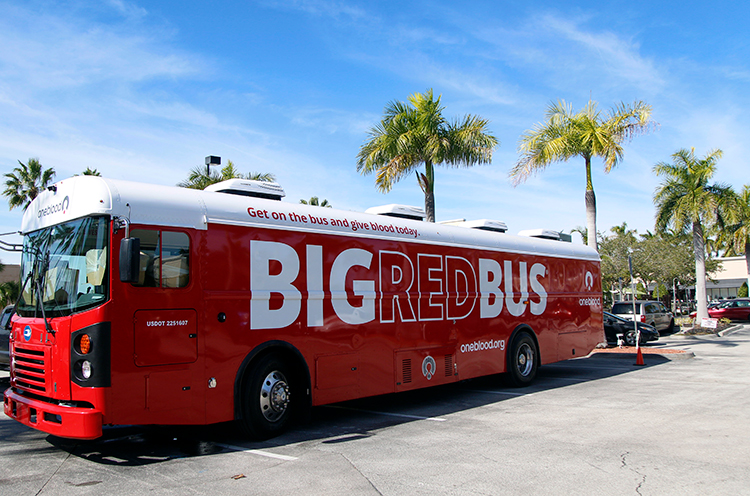
Vero’s local blood donation center is part of OneBlood, which serves over 250 hospitals in the southeast. Since about one in three people will need a blood transfusion sometime in their lifetime, the demand is constant and the need for donations is never-ending. As an example, a single car accident victim can require 100 pints of blood.
Happily, donating is easy and rewarding. Anyone in good health and over the age 16 is welcome to donate.
“Donating blood is actually good for your own health,” said Pat Michaels, OneBlood’s director of media and public relations. “You are getting a mini checkup and your cholesterol and vital sign readings will be posted in your online profile. It also helps reduce cardiovascular risk factors as it’s linked to lower blood pressure and lower risk of heart attacks. Your body will replace the blood volume (plasma) within 48 hours and completely replace the donated red blood cells in 56 days. Whole blood can be donated every 56 days and plasma every two weeks.
It’s kind of like getting an oil change in your car and most donors can complete the process in less 30 minutes.”
Getting donated blood to the person in need is an intricate journey of coordination that enables that life-saving unit to travel from the donor to the hospital. OneBlood maintains more than 200 blood mobiles, better known as the Big Red Buses, and 96 donor centers. All of the locations are fully staffed and stocked with supplies. Drinks and snacks are provided to the donors as well as a thank you in the form of an incentive-like gift cards, T-shirts, beach towels and blankets.
After you fill out a quick questionnaire, the phlebotomist will insert a needle into the vein in your arm, just as if you were having routine bloodwork. You’ll squeeze a rubber ball to help the flow of blood transfer through a tube to a bag which holds a pint of blood. Each whole blood donation has the potential to save up to three lives and there is no risk of contracting disease through the donation process as each kit is sterile, pre-packaged and only used once.
Once the donation is complete a courier takes the unit to a processing hub while sample tubes are sent for testing. Samples from every unit of blood are sent to a central lab where they undergo a battery of 18 tests, checking for HIV, Hepatitis and West Nile Virus.
The unit of blood then goes to a manufacturing laboratory where it is processed to its usable components and labeled. The blood products are then sent to distribution hubs, where they are stored until there is a hospital order and couriers deliver the orders to the hospitals that need it. OneBlood couriers drive about 2 million miles a year!
“While blood has a shelf life of 42 days, we utilize the blood within 3-5 days,” Michaels continued. “We don’t bank the blood. It’s a complex operation of testing and shipping that is operating 24 hours a day, seven days a week. What comes in gets tested and goes out right away. We will let the donor know where their blood is going within a few days, and it may be going to a different county entirely. We send it where a match is needed.”
So, we all know that we need blood to survive, and we process enough blood in our bodies to donate and help others, but what exactly is blood? Blood is made up of four main components: red blood cells, platelets, plasma and white blood cells.
The red blood cells represent 40 percent to 45 percent of your blood volume. They are generated from your blood marrow at a rate of 4 billion to 5 billion per hour and have a lifecycle of about 120 days in the body.
Platelets control bleeding. Whenever a wound occurs, injured blood vessels send out a signal.
Platelets receive that signal and travel to the area and transform into their ‘active’ formation, growing long tentacles to make contact with the vessel and form clusters to plug the wound until it heals.
Plasma is the liquid portion of the blood which transports water and nutrients to your body’s tissue.
White blood cells only account for 1 percent of your blood but they are essential as protection against illness and disease. Like the red blood cells, they are constantly being generated from your bone marrow. They flow through the bloodstream and attack foreign bodies like viruses and bacteria.
There are eight different blood types, and your specific blood type is inherited. Blood types and blood components must be matched exactly for a safe transfusion. There is a very targeted, complex science as to which types can be given or received by another.
And there are several ways to donate blood. Most donors donate whole blood, but your phlebotomist can assist you in determining if you are a candidate for double red cell, platelet or plasma donation, and advise you of each procedure.
To expand your blood donating efforts, consider hosting a blood drive. The Big Red Bus can roll up just about anywhere and OneBlood will provide you with everything you need from start to finish by working with a designated person from your organization.
At the holiday season people are encouraged to give the ultimate gift of life and donate blood.
It doesn’t cost you a dime and the life you save may be closer than you think. You can schedule an appointment at oneblood.com at a location near you or to set up your own blood drive.
OneBlood and all blood centers in the United States are regulated by the U.S. Food and Drug Administration (FDA). As a regulated agency, blood centers are required by law to follow all rules, guidelines and deferral policies put in place by the FDA.



